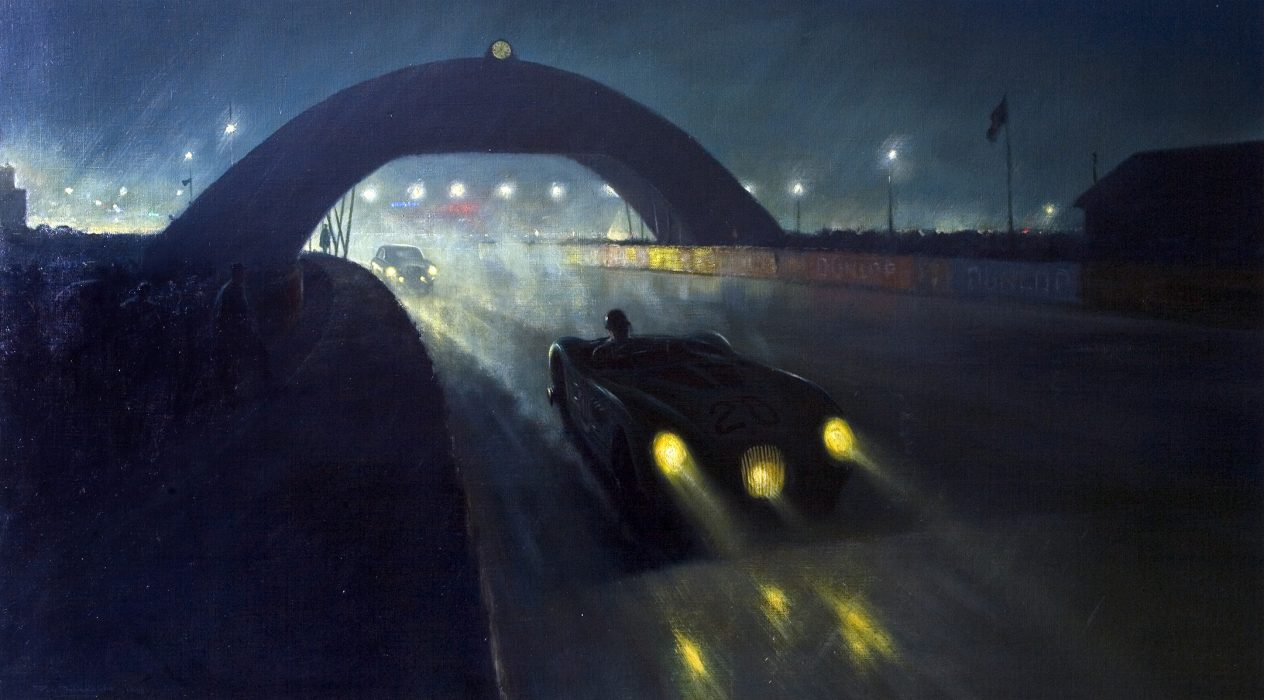
Nighttime at Le Mans, Roy Nockolds, 1951
The Artwork
This is one of nine paintings by artist Roy Anthony Nockolds in the Jaguar Daimler Heritage Trust’s Collection, and one of two that record Jaguar’s first victory at Le Mans in 1951, in a C-type driven by Peter Walker and Peter Whitehead.
Nockolds is well known for his use of light and dark to add drama to his paintings and he uses this technique to great effect in this composition. It rained for much of the practice day and the start of the 1951 race and although it dried up for a while that afternoon, the rain returned during the evening and continued for most of the night.
Nockolds has captured both the rain and the darkness in this picture which shows the C-type number # 20 leading the field through the famous Dunlop Bridge, with the pursuing car having to battle through the spray from the Jaguar. The car is shown almost as a solid mass with only the race number, the headlamps and central driving lamp visible, reflecting on the wet surface ahead. The lights from the grandstands behind help to light up the night sky to some extent but also serve to highlight the silhouette of the bridge and give some idea of the dark, wet conditions that the drivers have to battle.
Nockolds use of darkness extends to the background and not just main subject of the painting. While not clearly visible in this image on screen, there is a group of spectators standing in the rain and darkness beside the track in the bottom left of the painting. These are just visible on the actual painting itself due to the way it is lit. A single figure, of a caped Gendarme, is clearly visible sheltering from the rain underneath the bridge.
For a number of years this painting was on the wall behind the desk of Jaguar’s CEO and can be glimpsed in a promotional film, The Jaguar Difference, that was made in 1999, behind Nick Scheele then Chairman and Chief Executive.
The painting is currently on public display in the Collections Centre at the British Motor Museum at Gaydon.
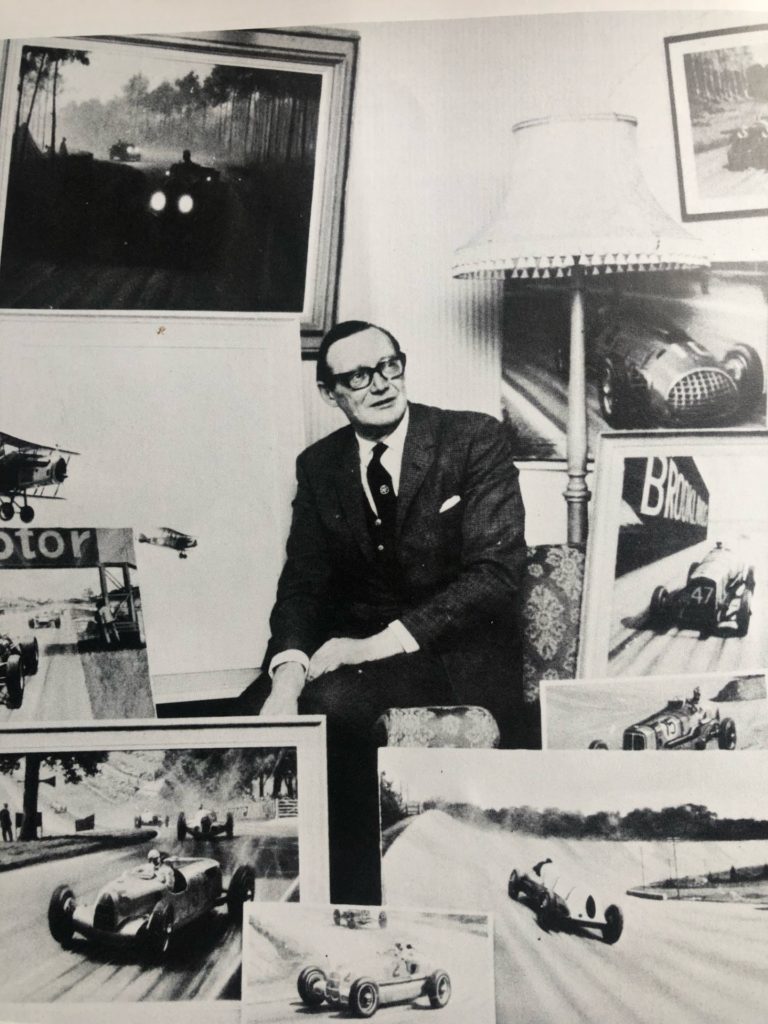
The Artist
Roy Nockolds was born in Croydon in 1911. He always claimed that his only successful subject was art and this was confirmed by two certificates from the Royal Drawing Society in 1922 (age 11) and 1923 (age 12). According to Nockolds’ recollections he first visited Brooklands in 1924 (age 13) where he became impressed by the power and speed of the racing cars and within two years, he was producing motoring art. By the time he was in his teens he was getting his pictures published in the motoring press. His early work was mainly pencil and charcoal drawings, but he also used ink, scraperboard, lino cut and dry point etching as well as watercolours.
F Gordon Crosby was already illustrating for The Autocar and Nockolds was fortunate to have most of his early work published by Motor Sport and Light Car. Although to his credit, Autocar was publishing full page reproductions of some of his etchings in 1932 (age 21). The first recorded exhibition of his work was in December 1934 at the Lombard Restaurant, Cheyne Walk, Chelsea. Around this time he was working as a freelance artist although some of his work was being used by The Motor to illustrate a weekly series of famous corners on racing circuits.
The start of war in 1939 brought a cessation of motor racing for the duration and Nockolds carried on working from his London studio as a general illustrator and for the services, particularly the RAF producing propaganda art.
[Photo courtesy of Nockolds’ daughter Rosanna Hackett]
In 1942 he was asked to look at improving the camouflage of night fighters. He noticed that a white owl was more difficult to see against a night sky than a dark bird. His idea was to paint the leading edge of the wing and underside of the aircraft white and the top of the aircraft black making it difficult to see from above and below. He prepared a painted model of a De Haviland Mosquito aircraft which was transferred to a full sized plane, resulting in the whole of 151 Mosquito Squadron being converted to the new scheme within days. Other camouflage work led to him being called up into the RAF, at the end of 1942 initially as a Clerk, but by 1943 he was posted to the aircraft research station at Farnborough where he had civilian status. He continued the propaganda paintings and his work on camouflage of aircraft, particularly bombers and accepted commissions to supplement his income. The end of the war saw the restart of racing and he resumed his motoring artworks including commissions from car makers such as Ford, Standard, Rover, Rolls-Royce and the Rootes Group and component manufacturers such as Lockheed and Lucas.
It was during this period that he was commissioned by Jaguar and some of the sponsors and suppliers to produce all the paintings that we have in our Artwork Collection. Nockolds’ connection with Jaguar began when the Esso Petroleum Company commissioned him to depict Le Mans 1951 when Peter Walker and Peter Whitehead drove their C-type through pouring rain to give Jaguar their first victory at Le Mans. He then worked closely with Jaguar’s PR Manager Ernest (Bill) Rankin for the next decade undertaking a series of commissions, many of race winning situations but also pictures for calendars, Christmas cards and advertising posters. He was a master of combining light and texture into his work to give the impression of speed and this comes across in several of our paintings.
His work was displayed in many exhibitions in the UK and twenty-four of his paintings were exhibited in New York in 1960 in an exhibition entitled ‘British Motoring Achievements’. This was a collection of paintings depicting outstanding performances of British cars during the previous ten years including some of our race winning Jaguar pictures.
Nockolds took a very keen interest in the Brooklands society founded in 1967, being an early Committee Member and the Chairman from 1976 to 1978, only resigning with the onset of ill health. He was elected Chairman of the Guild of Aviation Artists in 1975, and continued to paint late into his life before passing away in 1979.
Jaguar C-types and the 1951 Le Mans Race
Jaguar Cars entered three of their recently launched XK120s for the 1950 Le Mans race but these all appeared as ‘private entries’ as the Company did not feel it was ready to enter an official Works Team. One failed to finish with the others coming in 12th and 15th proving that overall the Company had a very strong package. Jaguar’s Team Manager Lofty England came to the conclusion that if they could produce a lighter car they would have one with the potential to win Le Mans for Jaguar.
The result was the C-types (XK120C) produced for 1951 which had the same engine, gearbox and running gear as the XK120s but the chassis was replaced with a lighter tubular steel frame clothed with an aerodynamic body built out of aluminium. Jaguar Cars fielded a Works Team of three C-types. The one driven by a young Stirling Moss and Jack Fairman was to act as ‘hare’ leading the race and encouraging the following cars to chase in the hope they would not complete the full course. In the event two of the C-types themselves failed to finish but left C-type car # 20 of Peter Walker and Peter Whitehead in the running to win the race by a full nine laps.
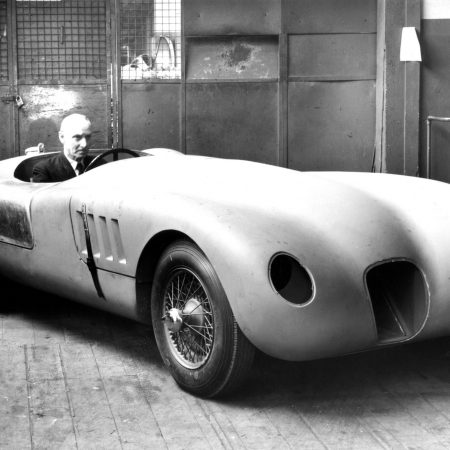
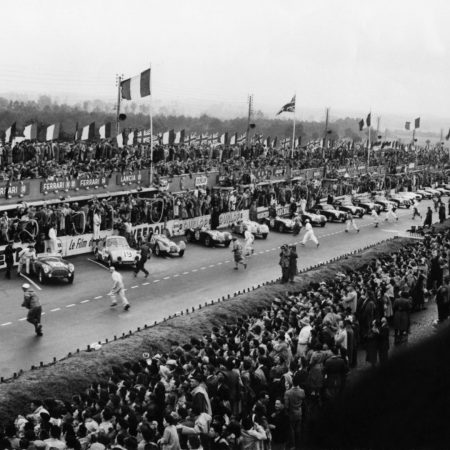
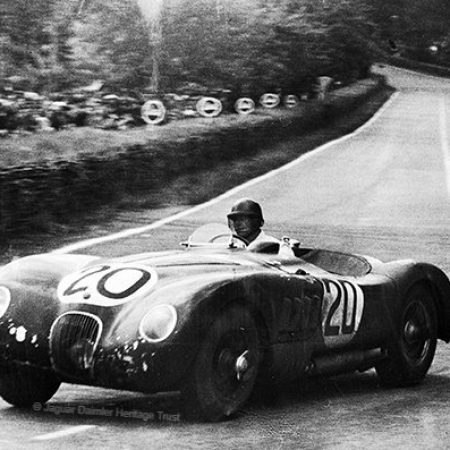
For a relatively young company, having only built cars since 1928, the achievement of winning Le Mans with a new car, first time out, is a feat that should not be under-stated.
The three C-types were chassis XKC001, 002 and 003 with Walker/Whiteheads car # 20 being XKC003. This car carried on racing during 1951 and into 1952, at Dundrod in Northern Ireland in September 1951, Goodwood in April ’52, the Mille Miglia in May (the first time a disc braked car was entered for the Mille), and then the Monaco Grand Prix in June.
XKC003 was then returned to the factory and dismantled and no longer exists.
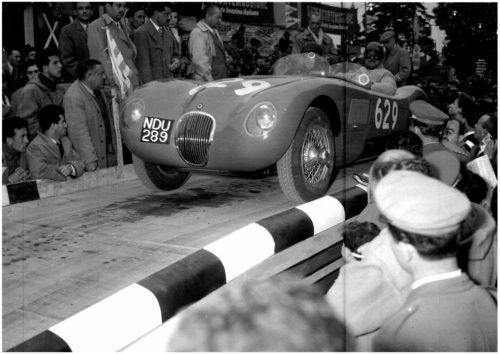
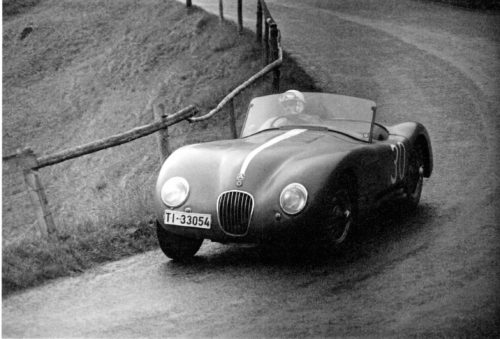
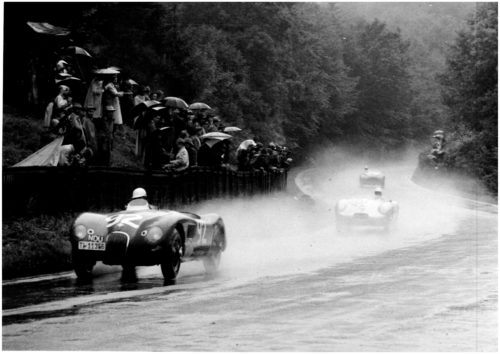
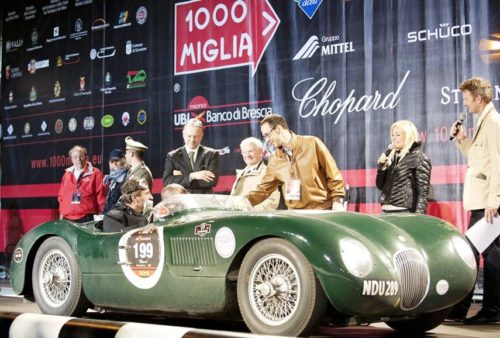
1953 C-type NDU 289
The Jaguar Daimler Heritage Trust does have a C-type in our collection but one from 1953 and not 1951. It was ordered by Italian racing driver Mario Tadini to enter for the Mille Miglia and was built before disc brakes became an option. Tadini did not finish the Mille Miglia and in 1954 the car was sold on to Swiss racing driver Ivo Badaracco who raced it on a number of occasions. It was sold on again in 1961 to Silvio Moser and then went through a number of changes of ownership.
JDHT bought it in 1983 and it is normally on display at the British Motor Museum at Gaydon. The car is MOTed annually and kept in running and driving condition. It has been run at Goodwood, Coventry Motofest and numerous other Jaguar related events.
Click the button for more information on NDU 289: